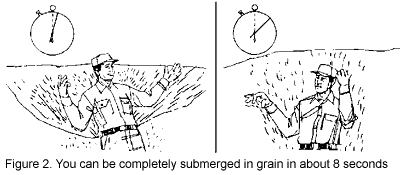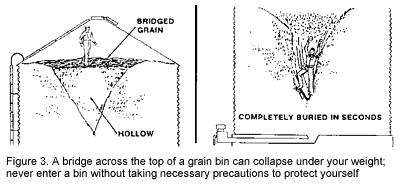Storage and handling of large volumes of grain on Missouri farms is common. In 1978, on-farm storage capacity for shelled grain was approximately 309 million bushels. Much of this grain is stored in bins with capacities ranging from 20,000 to 100,000 bushels.
Grain is also handled more quickly today. Today's large augers can transfer from two to four times as much grain as the augers of the past. Also, using automated equipment often means a farmer works alone most of the time.
Increased storage capacities, larger and faster handling capacities and automation contribute to many potentially hazardous situations during the harvest and storage season. This guide sheet identifies many of them and suggests preventive measures that control or eliminate the hazardous exposure.
SUFFOCATION
The typical round, flat-bottomed grain bin draws grain from the top center and forms a vertical cone when emptying. The 8-inch auger, common on many Missouri farms, can transfer 3,000 cubic feet of grain per hour (52 cubic feet per minute). Your body volume, which is about 7 cubic feet, can be completely submerged in grain in about 8 seconds (see Figure 1).

Because of the tremendous force flowing grain exerts on your body, you are totally helpless to escape once you are trapped knee-deep in the grain.
Crusted, spoiled grain can also result in a grain bin suffocation (see Figure 2). As grain is removed from the bin, a cavity develops under the crusted surface. Unsuspecting victims walk on the crusted grain, break through, become submerged in the grain, and suffocate.
In addition, spoiled grain can also form large vertical masses. If you try to get the caked material loose, large sections of grain can break off and cover you. This risk increases as the capacity of the bin increases. When you are breaking up large masses of caked grain, use a long pole and work from a manhole above the grain. Use a wooden pole because of the danger of overhead power lines.

If you become trapped in a bin of flowing grain with nothing to hold onto but you are still able to walk, stay near the outside wall. Keep walking until the bin is empty or grain flow stops. Also, if you are covered by flowing grain, cup your hands over your mouth, and take short breaths. This may keep you alive until help arrives.
CARBON DIOXIDE
If you suspect the presence of carbon dioxide in the grain bin, don't go inside. To reduce the hazard, open manholes and all side door openings and force air through the bin.
If you attempt a rescue in an oxygen-deficient atmosphere, you must have a self-contained breathing apparatus.
Your local emergency rescue team is trained and has the equipment to help in this type of an emergency. Call them immediately.
SAFETY MEASURES
Ladders. Vertical, fixed ladders accessible from the inside wall or roof opening provide a path of escape if an emergency arises. A rope with knots or a chain or pipe ladder hanging from the roof peak can provide alternate escape routes. Vertical ladders fixed on the outside wall that are over 20 feet high should be equipped with a cage. This measure reduces the hazard of falling. Vertical ladders should have rest platforms located every 30 feet.
Climbing on the roof of a grain bin to open and close the center roof cover often is necessary when loading it with a portable auger, inspecting, servicing, or determining the amount of grain left in the bin. The roof ladder should be readily accessible from the vertical wall ladder fixed on the outside wall. Hand loop rails at the top of the vertical ladder, hand rails on the roof ladder and guard rails around the manhole are desirable safety features. They reduce the risk of falling while climbing.
Lock out. You should be able to turn off and padlock the power switch, so no one can turn on the power when you or others are working in the grain bin. (If you have employees, review the Occupational Safety and Health Administration (OSHA) requirements under the Machinery Guarding Standard.)
Safety decals. On newly constructed grain bins, safety decals placed at strategic locations on the bin should alert workers to the dangers of flowing grain, crusted over grain, and carbon dioxide.
Operating procedures. Suffocation doesn't have to happen. Follow these safety rules to protect yourself and others:
RESCUE PROCEDURES
The most successful way to rapidly remove a victim is to cut large holes around the base of the bin, approximately 5 feet up from the base. (Always beware that if you cut too many holes, the bin may collapse on you.) Cutting holes reduces the volume of grain from the bin in the shortest period of time. Gain access into the grain bin side walls by using the front-end loader of a tractor, an abrasive saw, or an air chisel. A cutting torch is a last resort because of the dangers of fire and explosions from dust and fumigant residue.
Using a drum with both ends cut to drop around the victim is another rescue technique. The drum in place around the victim can reduce the force of the grain on the trapped victim.
When you must enter the grain bin, have several people assist you from the outside. At least two people should be available. Enter with a rope and safety harness so they can lift you out in case of an accident.
Do not attempt a rescue in an oxygen-deficient atmosphere. Call your local emergency rescue team. They have the training and equipment to do the job safely.
HEALTH HAZARDS
Nuisance dust is light enough to be carried by air currents and small enough to be inhaled and deposited in your lungs. A common danger in the air, this dust can accumulate and turn parts of the lung into non-functioning, hardened tissue. Inhaled dust also encourages the growth of tuberculosis and bronchitis. To protect your lungs, wear an approved dust mask and ventilate the work area, while you clean out a grain bin or work with dusty grain.
Exposure to fungus from moldy grain can result in allergic reactions, characterized by chills, high fever, swelling, vomiting, dizziness and shortness of breath. The lungs can fill with fluid and collapse. An approved dust mask that fits tightly around the mouth and nose area effectively protects you from fungus present in moldy grain. If you choose not to wear a mask, there is a good chance you will have an allergic reaction and have breathing problems the rest of your life.
Fumigants. Another potential health hazard exists during and after fumigation of a grain bin. Fumigants are toxic to humans when inhaled, swallowed, or absorbed through the skin. If you follow safety procedures, you can eliminate the potential for poisoning.
Observe and follow all label recommendations. Selecting and fitting the proper gas mask and canister and using them correctly will protect you. Use only those gas masks and canisters that have been tested and approved by the National Institute for Occupational Safety and Health (NIOSH) or the U.S. Bureau of Mines. Post warning signs alerting people to the dangers of fumigation. Always run the ventilation fan before entering the bin to ensure that the environment is not immediately dangerous to your life and health.
Most producers find that it is often safer, cheaper and more effective to have their stored grain fumigated by a licensed, professional fumigator.
HAZARDOUS EQUIPMENT
Take a few minutes to review the operator's manual and examine the equipment to ensure it is in safe operating condition.
Wear close-fitting clothing when you are working near power augers. Loose, floppy clothes can become caught in moving parts and draw you into the auger.
Have guards and shields in place to decrease the chances of getting caught in moving parts. It is critical that all shields and guards be replaced as soon as repair and maintenance work is completed. A machine that is properly guarded can save your life or the life of a family member.
Exposed auger flighting should be guarded with either grated or solid baffle style covers. Grated guards should have an opening no larger than 4-3/4 inches long. Each individual rectangular opening should be no larger than 10 square inches and be no closer than 2-1/2 inches to the rotating flighting. Slotted openings in solid baffle style guards should be no wider than 1-1/2 inches or closer than 3-1/2 inches to the exposed auger flightings.
Children are attracted to the operation of a grain auger. They move in closer to get a better look and can become entangled. It is important that children be instructed to stay away from operating equipment.
Transporting, positioning and raising a portable auger can be hazardous if safe work procedures are violated. Before moving an auger, lower and secure it in transport position. Check for overhead power lines before positioning the augers to avoid contacting a high voltage source. You could be electrocuted by becoming the direct circuit to ground. If contact is made or a power line is broken, have someone call the power company. Stay on the tractor or truck unless you can jump clear. Do not touch anything in contact with the power line.
Avoid sharp turns when pulling a portable auger because the wheels do not follow those of the tractor pulling it. Travel at safe speeds on the highway and have a flag mark the end of the auger and a slow-moving vehicle sign on the auger frame.
Raising an auger too high increases its chances of upending. Accidents occur when the undercarriage falls. When in use, the upper end of the auger should be resting on the top of the bin and the lower end resting on the ground. Stay out from under an auger while it is being raised.
Transport equipment. Suffocation in a gravity wagon or truck can occur when children or other innocent victims slip and are drawn into the grain during unloading. Do not allow anyone on or in the wagon or truck at any time. Make sure to properly mark any equipment moved on a public road in Missouri with a slow-moving vehicle emblem or lights.
Grain dryers. Grain dryers may reach a maximum temperature of 240 degrees F during the drying operation. A fire extinguisher should be available (see MU publication G01906, Selecting a Fire Extinguisher). Also, be aware of the high noise levels created by the high-speed, high-volume fans used with grain dryers. Wearing ear muffs will protect you from permanent hearing damage, which can occur after exposure to high noise levels for long periods (see MU publication G01962, Noise: The Invisible Hazard).
SUMMARY
Keep these safety measures in mind when storing and handling grain:
REFERENCES
Publication #: GO1969
This document is apart of a series from the University Extension, University of Missouri-Columbia, Columbia, MO 65211. Publication date: October 1993.
David E. Baker, Department of Agricultural Engineering, University of Missouri-Columbia, Columbia, MO 65211.
Disclaimer and Reproduction Information: Information in NASD does not represent NIOSH policy. Information included in NASD appears by permission of the author and/or copyright holder. More